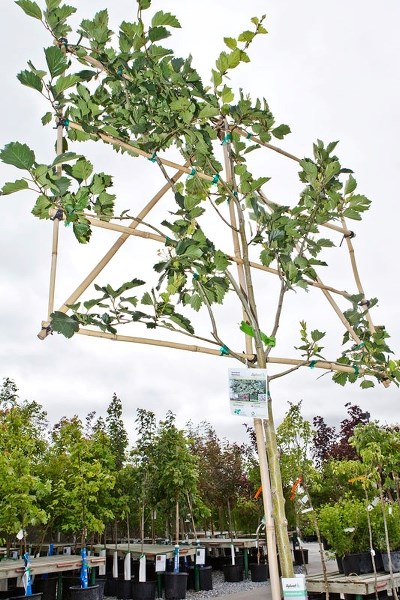Imagine a tree that looks more like a poodle than a juniper. A Sea-Green Juniper has big round balls like a carefully trimmed poodle, and indeed, the needles are shaved to give it its shape.
Next, think of a tree that looks like an old man’s walking stick lying flat on the ground and you might be envisioning something like a Pinus Banks Uncle Fogy pine tree. Uncle Fogy’s branches are humped and knotted giving it an aged appearance as it shapes itself to its surroundings.
All these trees are part of a new designer style of tree developed especially for small spaces. They are so interesting; they look as if Dr. Seuss might have drawn them.
“They are specialty trees designed to be shown off as focal points in the yard,” said Stephen Raven, who is the green-goods buyer for Hole’s Greenhouses and Gardens.
The poodle-shaped Sea-Green Junipers must be pruned to maintain their form, or they could revert back to their original pyramidal shape. Similarly, Spiral Junipers, which as the name suggests twist and turn with a series of S curves, must also be pruned. But Old Uncle Fogy might never have to be pruned.
“Uncle Fogy pines are sprawling and not supposed to have a specific shape,” Raven said.
Another sprawling tree is a Niagara Falls White Pine that grows horizontally instead of in an upright fashion.
“Its natural habitat would be growing sidewise, perhaps on a creek bed. But it would look awesome on a two-level yard with a retaining wall, if it cascaded over the wall,” Raven said.
Tree hybridizers are also breeding trees to be tall and slender, so that they have a columnar shape. Columnar Aspen Poplars have been around for some time, but now almost any tree that you may be familiar with comes in a columnar shape.
“You can get Columnar Flowering Crabapple trees. They have a nice church-spire shape, with a pointy top and a wider base, a very nice bronze leaf and a pink flower. There’s also a columnar variety called Purple Spire Crabapple,” said Tam Andersen of Prairie Gardens and Greenhouses.
Columnar Mountain Ash trees grow to a height of six metres and are about a metre wide at the base. Like the more familiar mountain ashes, they still have red berries, which are good for the birds and add fall beauty, but are sometimes found to be a nuisance when they fall on the ground.
“It’s pretty hard to find the perfect tree,” said Raven.
A row of columnar-shaped trees can make a fine privacy screen.
“The breeders realize people have smaller yards so there are more columnar varieties than there were 25 years ago. There are columnar hawthorn trees, columnar linden trees, columnar Colorado blue spruce and columnar Norway spruce,” Raven said.
Trees are being pre-shaped to fit the mould that the landscapers desire. Espalier-pruned trees are pruned and tied to a frame so that they grow flat on one side.
“Espalier trees are especially popular in the Netherlands where their yards are so teeny. This way you have a tree without using a whole bunch of space in the yard. In Europe it’s common to see apple trees that have been pruned in the Espalier fashion, so they still have fruit but the trees are flat against a fence,” Raven said.
Differently coloured conifers are designed to make them more noticeable, particularly when grouped with other evergreens.
A Pinus strob louie is a dwarf pine that is a lovely golden yellow. Similarly a Golden Oriental Spruce only grows to a height of seven metres, and it is a pretty lemon shade. Fire Chief Juniper is green with reddish tips and a variety of Korean Fir has silver undersides, so that as the needles flip in the wind you have a two-toned silver-green effect.
Mini-twist Scotch Pine is a soft yellow pine and the needles naturally have a twist to them, producing a very-full looking shrub.
“The advantage to many of these specialty trees is that they are very slow growing. It probably took ten years to grow the Mini Twist to a one-metre height,” Raven said.
A slow-growing oak tree is the Northern Pin Oak, which is hardy enough to withstand Alberta winters and lives to be 200 to 300 years old.
“It’s slow-growing so in some respects you are planting it for the next generation. Eventually it will be in the 100-foot range but it will take three generations to get there. Still, it might be better on an acreage than in a small yard. In the fall it has red leaves,” Andersen said
Another differently coloured deciduous tree is the Dakota Pinnacle Birch.
“It’s a tall slender tree that will grow to 10 or 13 metres so it will be a significant tree. But the leaves are light and airy so you can see around it and through them and they have a beautiful yellow colour,” Andersen said
Trees can be planted anytime from May until freeze-up.
“The only rule is don’t fertilize after August 1 so the trees don’t think you are still telling them to grow.”




